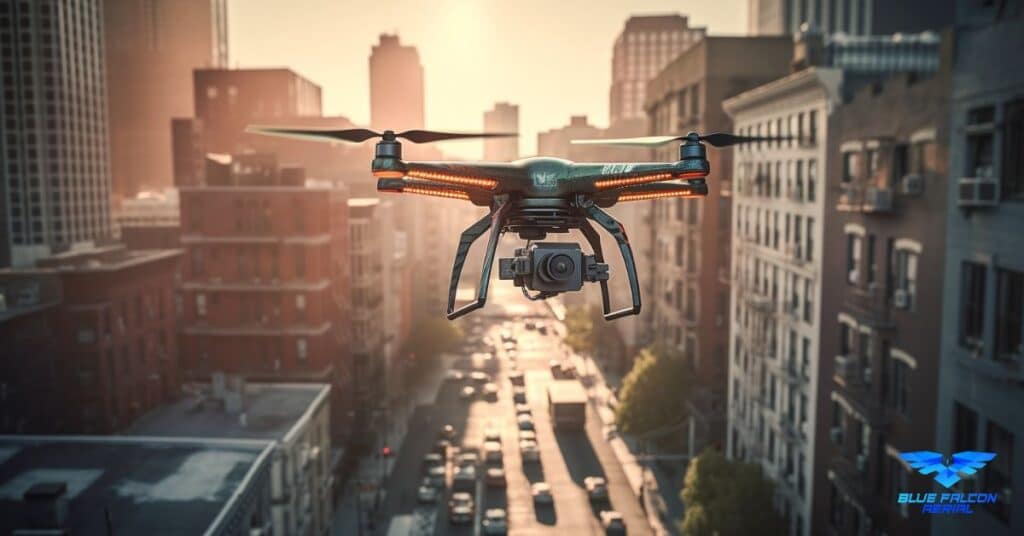The drone industry has seen rapid growth in recent years, with various countries competing to become leaders in this emerging market. One question that’s often debated is: Why are Chinese drones better than American ones? In this comprehensive article, we’ll delve into the factors that have led to China’s dominance in the drone market. We’ll explore the technological advancements, cost-effectiveness, flight performance, and unique features that set Chinese drones apart from their American counterparts. We’ll also discuss the drawbacks and limitations of American drones compared to Chinese models, as well as the impact of these differences on the drone industry as a whole. By the end, you’ll have a clear understanding of why Chinese drones are outperforming their American counterparts and what this means for the future of the industry.
Market Overview
Global Drone Industry
The global drone industry has experienced substantial growth in the past decade, with the market size expected to reach $58.4 billion by 2026, at a compound annual growth rate (CAGR) of 15.2% from 2021 to 2026. This growth has been fueled by increasing demand for drones in various sectors, such as agriculture, real estate, construction, photography, and defense, among others.
Leading Countries in Drone Technology
Several countries have emerged as leaders in drone technology, with the United States and China being the most prominent players. While the US has been a pioneer in developing military drones, China has managed to dominate the commercial and consumer drone market. Other countries such as Israel, Canada, and the United Kingdom have also made significant contributions to the drone industry.
Advantages of Chinese Drones over American Drones
Technological Advancements
One of the key factors that set Chinese drones apart from their American counterparts is their cutting-edge technology. Chinese drone manufacturers have focused on continuous innovation, developing advanced features such as obstacle detection, tracking capabilities, and intelligent flight modes. For example, DJI’s Phantom 4 Pro boasts a 5-direction obstacle sensing system, allowing the drone to detect and avoid obstacles in its path.
Cost-effectiveness
Chinese drones have gained a reputation for offering a high price-performance ratio. They often provide similar or even better features than American drones but at a fraction of the cost. This makes them an attractive option for both professionals and hobbyists who are looking for high-quality drones without breaking the bank.
| Drone Model | Country of Origin | Price | Camera Resolution | Flight Time |
|---|---|---|---|---|
| DJI Phantom 4 Pro | China | $1,599 | 20 MP | 30 min |
| Autel EVO II Pro | China | $1,795 | 20 MP | 40 min |
| GoPro Karma | United States | $1,099 | 12 MP (GoPro) | 20 min |
| 3DR Solo | United States | $999 | 12 MP (GoPro) | 20 min |
Flight Performance and Stability
Chinese drones are known for their excellent flight performance and stability. They often come equipped with powerful motors, advanced GPS systems, and sophisticated flight controllers, ensuring smooth and precise flight even in challenging conditions. For instance, DJI’s Mavic 2 Pro can maintain a stable hover in winds up to 29-38 kph.
Unique Features and Capabilities
Chinese drone manufacturers have been successful in differentiating their products by introducing unique features and capabilities not found in American drones. Some of these features include 360-degree camera rotation, infrared imaging, and modular designs. The Autel EVO II series, for example, offers interchangeable camera modules, allowing users to switch between 8K, 6K, and thermal imaging cameras.
Drawbacks and Limitations of American Drones
American drones, on the other hand, have faced several challenges that have limited their competitiveness compared to Chinese models. Some of these challenges include high production costs, slower innovation cycles, and a focus on the military market rather than consumer or commercial applications. These factors have resulted in American drones often being more expensive and less feature-rich than their Chinese counterparts.
Comparing Chinese and American Drone Manufacturers
Manufacturing and Supply Chain
One of the key factors contributing to the success of Chinese drone manufacturers is their efficient manufacturing and supply chain management. China’s well-established electronics manufacturing industry provides Chinese drone companies with easy access to a vast range of high-quality components at competitive prices. This allows them to produce drones with advanced features while keeping costs low.
In contrast, American drone manufacturers often face higher production costs due to a less-developed domestic supply chain for drone components. This often results in higher-priced drones with fewer features compared to their Chinese counterparts.
Government Support
Chinese drone manufacturers benefit from strong government support, which has played a significant role in their success. The Chinese government has invested heavily in research and development, as well as infrastructure projects related to the drone industry. This support has enabled Chinese drone companies to innovate and scale their businesses rapidly.
In comparison, American drone manufacturers have received relatively less support from the government, particularly in the commercial and consumer drone sectors. The US government has primarily focused its attention on military drone technology, leaving commercial and consumer drone manufacturers to compete with limited resources.
Performance Comparison: Chinese Drones vs. American Drones
When comparing the performance of Chinese and American drones, it’s essential to consider factors such as flight time, range, camera quality, and payload capacity. In many cases, Chinese drones outperform their American counterparts in these aspects.
Flight Time
Chinese drones typically offer longer flight times than American drones, allowing users to capture more footage or cover larger areas in a single flight. For example, the DJI Mavic 2 Pro offers a flight time of up to 31 minutes, while the American-made GoPro Karma has a flight time of only 20 minutes.
Range
Chinese drones also tend to have a greater range than American drones, enabling users to fly further from their starting point. For instance, the Autel EVO II Pro has a maximum range of 9 km, while the American 3DR Solo has a range of only 1 km.
Camera Quality
In terms of camera quality, Chinese drones are often on par with or surpass American models. The DJI Phantom 4 Pro, for example, comes with a 20 MP camera and can record 4K video at 60 fps. In comparison, the GoPro Karma requires a separately purchased GoPro camera and offers 12 MP stills and 4K video at 30 fps.
Payload Capacity
Chinese drones can also carry larger payloads than many American drones, making them more versatile for various applications such as aerial photography, mapping, and surveillance. The DJI Matrice 300 RTK, a popular industrial drone, can carry a payload of up to 2.7 kg, while the American-made Parrot Anafi USA has a payload capacity of just 500 g.
Key Features of Chinese Drones That Surpass American Models
Chinese drones have consistently demonstrated a number of advanced features that set them apart from American models. Some of these key features include:
Obstacle Avoidance
Many Chinese drones are equipped with sophisticated obstacle avoidance systems that enable them to detect and avoid obstacles in their path. This technology greatly enhances safety and helps prevent collisions, particularly when flying in complex environments.
Intelligent Flight Modes
Chinese drones often come with a variety of intelligent flight modes, such as waypoints, follow-me, and orbit. These modes allow users to perform complex maneuvers and capture dynamic footage with ease, making them particularly popular among aerial photographers and videographers.
Modular Design
Some Chinese drone models offer a modular design, allowing users to easily swap out components, such as cameras or gimbals, to suit their specific needs. This flexibility makes Chinese drones more versatile and adaptable for a wide range of applications.
User-friendly Interface
Chinese drone manufacturers have placed a strong emphasis on user experience, developing intuitive and user-friendly interfaces for their drones. This makes it easy for users of all skill levels to learn how to operate and control their drones, reducing the learning curve and making it more accessible to a wider audience.
Innovation in the Chinese Drone Industry
The Chinese drone industry has been at the forefront of innovation, driven by a combination of government support, a thriving electronics manufacturing sector, and a strong focus on research and development. Some key areas of innovation in the Chinese drone industry include:
AI and Machine Learning
Chinese drone manufacturers are increasingly incorporating artificial intelligence (AI) and machine learning technologies into their products. This allows drones to analyze data in real-time, make decisions autonomously, and perform tasks more efficiently.
Swarm Intelligence
Swarm intelligence is an emerging area of research in the Chinese drone industry, which involves the development of algorithms that enable multiple drones to work together in a coordinated manner. This technology has potential applications in areas such as agriculture, search and rescue, and surveillance.
Drone Delivery
Chinese companies are actively working on developing drone delivery systems that can transport goods quickly and efficiently, particularly in hard-to-reach areas or during emergencies. This technology has the potential to revolutionize logistics and supply chain management, making it faster and more cost-effective.
Advanced Battery Technology
Battery life has long been a challenge for drone manufacturers. Chinese companies are investing in research and development to create advanced battery technologies that can provide longer flight times and shorter charging periods, enhancing the overall performance and usability of drones.
By focusing on these innovative areas, the Chinese drone industry continues to push the boundaries of what is possible and maintain its competitive edge over American and other global drone manufacturers.
Case Studies
To better understand the dynamics between Chinese and American drone manufacturers, let’s examine a few case studies of successful Chinese companies and struggling American counterparts.
DJI: The Success Story
DJI, a Shenzhen-based company, has become the world’s leading drone manufacturer. With a wide range of products catering to various markets, DJI has captured a significant share of the consumer, professional, and industrial drone sectors. Some of the factors contributing to DJI’s success include:
- High-quality products with advanced features at competitive prices
- Continuous investment in research and development
- Rapid adoption of new technologies, such as AI and machine learning
- A strong global brand and marketing presence
Autel Robotics: The Rising Star
Another Chinese company making a significant impact in the drone market is Autel Robotics. Known for their EVO series of drones, Autel has gained popularity by offering a combination of high-performance capabilities and user-friendly interfaces. Key factors contributing to Autel’s success include:
- A focus on innovation and product development
- An emphasis on customer service and support
- Competitive pricing and value for money
The Decline of GoPro Karma and 3DR
On the other hand, American drone manufacturers GoPro and 3D Robotics have struggled to compete with their Chinese counterparts. The GoPro Karma drone faced numerous issues, including a recall due to power failures during flight, which ultimately led to the discontinuation of the product. 3DR’s Solo drone also failed to gain traction in the market, and the company eventually pivoted towards enterprise solutions.
Factors contributing to the struggles of these American drone manufacturers include:
- Higher production costs and less efficient supply chain management
- Slower adoption of new technologies and innovations
- Less competitive pricing compared to Chinese models
The Impact on the Drone Industry
The dominance of Chinese drone manufacturers has had significant effects on the global drone market and the industry as a whole.
Effects on the Global Market
Chinese drone manufacturers, particularly DJI, have established a strong presence in the global market, capturing a significant share in both the consumer and professional sectors. This has made it increasingly challenging for American and other international drone manufacturers to compete, leading to consolidation and a decline in the number of competitors.
Technological Advancements
The success of Chinese drone manufacturers has also driven technological advancements in the industry. By focusing on research and development, Chinese companies have accelerated the adoption of new technologies such as AI, machine learning, and swarm intelligence. This has helped push the boundaries of what is possible with drones and expanded their potential applications.
Future Outlook
Looking ahead, the dominance of Chinese drone manufacturers is likely to continue as they continue to invest in research and development, capitalize on emerging technologies, and maintain their competitive pricing advantage. American drone manufacturers will need to adapt and find new ways to differentiate themselves to remain competitive in the market.
However, it’s worth noting that the drone industry is still evolving, and new technologies or market shifts could potentially disrupt the current landscape. As a result, the future of the drone market remains uncertain, with opportunities for both Chinese and American manufacturers to innovate and thrive.
In conclusion, the success of Chinese drones can be attributed to a variety of factors, including their technological advancements, cost-effectiveness, flight performance, and unique features. Additionally, the strong manufacturing and supply chain support, as well as government backing, have given Chinese drone companies an edge in the market. This has not only led to the decline of some American competitors such as GoPro Karma and 3DR but also pushed the Chinese drone industry to innovate and evolve further.
For those interested in capitalizing on the growth of the drone market, we recommend visiting our comprehensive guide to building and growing your drone business. This resource will provide valuable insights into navigating the complex landscape of the drone industry and help you make informed decisions about your own drone ventures.
If you’re in need of drone services or have any questions, don’t hesitate to contact Blue Falcon Aerial for expert assistance. We’re here to help you take your business to new heights!




